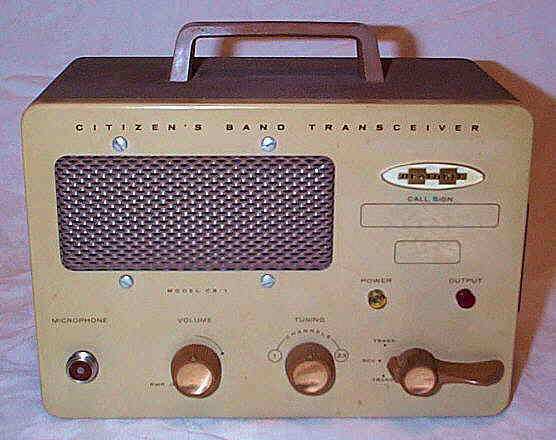

This is the Heathkit CB series "lunchbox" radio. This was one version of a bunch of similar radios, which were made for various ham bands. At one time, building your own CB radio was allowed as well, so this radio translated well for that purpose. This radio features a tunable super regenerative receiver and a single crystal controlled transmit channel. Rounding out the controls was a 3 position transmit/receive switch, which was normally in the middle receive position, and you had the choice of a spring loaded transmit position one way, and a locked on transmit position in the opposite direction. Neon power and red transmit indicators, and a Turner ceramic hand mic were standard equipment as well. Heathkit sold a number of these radios in the early 60's, and there are still a few running around the hamfest circles, mostly as collector's items.
I fondly remember one such radio, which found its way into our fledgling kids Channel 14 CB group in 1973. It was originally owned by a guy by the handle of "Bone Man". He then sold it to one of my friends, Gilbert, who had been previously running a 100 mW walkie-talkie. We made an antenna for it out of an old telescopic walkie-talkie antenna, and mounted it outside his window. While not very efficient compared to commercial CB antennas, it was still better than a 100 mW walkie-talkie indoors. Gilbert was now much stronger in signal than he used to be. There was a bit of dissent among the older teenagers about selling this radio to one of the "kiddies", and they had concerns about any of us becoming too "powerful". Steve took care of things by innocently offering to relocate the crystal socket to the front panel of the radio, so that we could change transmit channel crystals without removing the cover. But while he had the radio, he also turned the power down to less than 1 watt. When Gilbert got the radio back, he noticed that it wasn't working as it once did. I offered to look at it, and by using my kit-built field strength meter, I managed to get the power back up to its former glory. Gilbert and I then sat in my garage that night, hooked the radio up to a homemade 9 foot antenna, and we proceeded to get some radio checks on a few different channels. We got reports of good signals as much as 4 miles away. It wasn't long before we attracted the attention of Steve, who soon realized that I had managed to undo his sabotage. He then came barreling down to my house, with some hokey story about the radio self destructing if it wasn't tuned "just right". But after his first deception, we wouldn't let him touch it. The simplicity of this radio and the ease at which I was able to tune it up, left an impression on me and was the main reason why I wanted a tube-type radio later on.
But alas, the radio was not destined to last long in any case. Not to long after Gilbert finally had it up and running, it developed a problem with the transmit/receive switch. One of the contacts had bent, and it snapped off while trying to straighten it. Once again Steve offered to fix it, and since I had no way to repair the switch, Gilbert reluctantly gave it to Steve to fix. Steve sat on it for a long while, but never fixed it. The radio eventually ended up in another CB'er's hands, who attempted to replace the T/R switch with a relay, so that he could use it with a push to talk mic. He was never fully successful to the best of my recollection, and the radio never really ever saw air time again in my area. Who knows where it may be now.